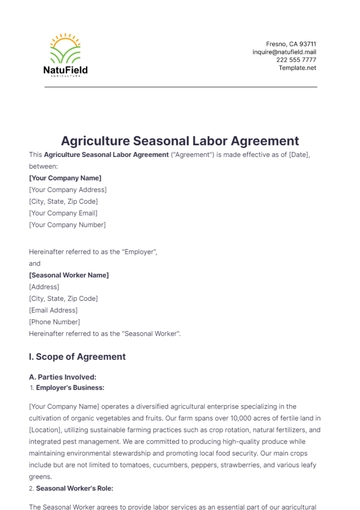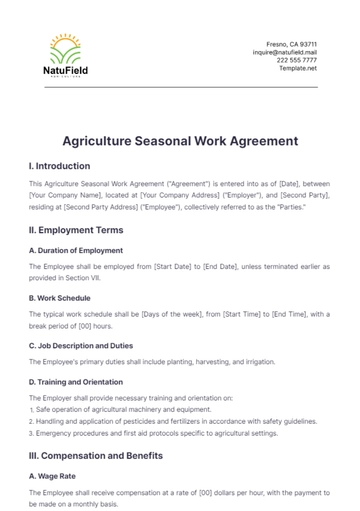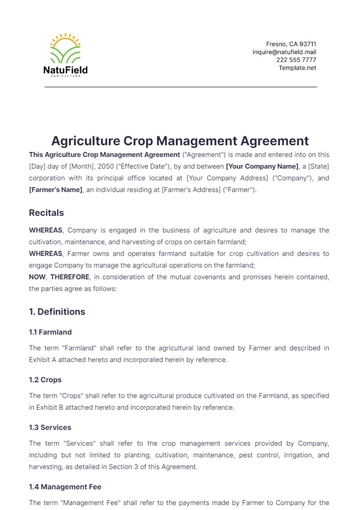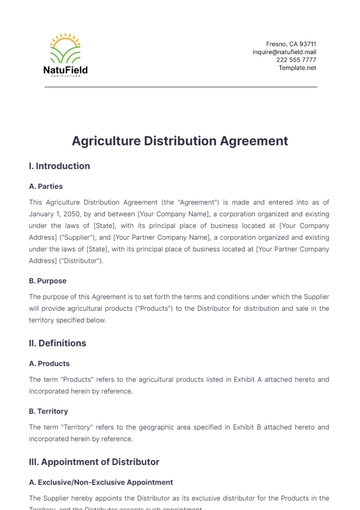Free Agriculture Safety Agreement
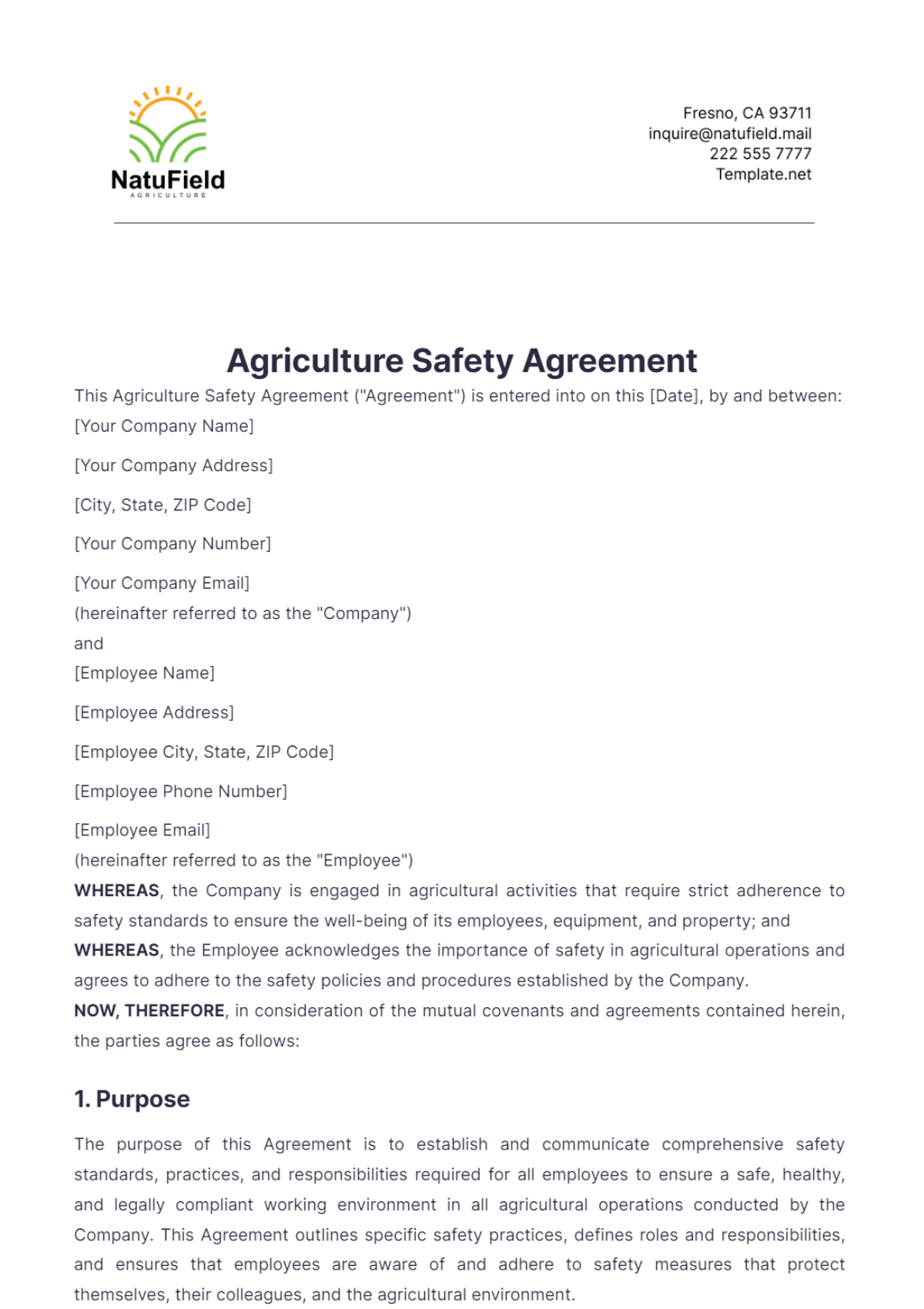
This Agriculture Safety Agreement ("Agreement") is entered into on this [Date], by and between:
[Your Company Name]
[Your Company Address]
[City, State, ZIP Code]
[Your Company Number]
[Your Company Email]
(hereinafter referred to as the "Company")
and
[Employee Name]
[Employee Address]
[Employee City, State, ZIP Code]
[Employee Phone Number]
[Employee Email]
(hereinafter referred to as the "Employee")
WHEREAS, the Company is engaged in agricultural activities that require strict adherence to safety standards to ensure the well-being of its employees, equipment, and property; and
WHEREAS, the Employee acknowledges the importance of safety in agricultural operations and agrees to adhere to the safety policies and procedures established by the Company.
NOW, THEREFORE, in consideration of the mutual covenants and agreements contained herein, the parties agree as follows:
1. Purpose
The purpose of this Agreement is to establish and communicate comprehensive safety standards, practices, and responsibilities required for all employees to ensure a safe, healthy, and legally compliant working environment in all agricultural operations conducted by the Company. This Agreement outlines specific safety practices, defines roles and responsibilities, and ensures that employees are aware of and adhere to safety measures that protect themselves, their colleagues, and the agricultural environment.
2. Scope
This Agreement applies to all employees, contractors, and visitors engaged in or visiting any agricultural operations managed by the Company. This includes but is not limited to fieldwork, machinery operation, maintenance activities, chemical handling, and any other activities associated with agricultural production. This Agreement also covers any work performed on the Company’s premises and during off-site activities related to Company operations.
3. Safety Policies and Procedures
3.1 General Safety Responsibilities
Employee Responsibilities
Employees are expected to:
Follow Safety Policies: Adhere to all safety policies and procedures outlined in this Agreement and any additional safety instructions provided by the Company.
Wear Personal Protective Equipment (PPE): Use required PPE such as hard hats, gloves, safety glasses, ear protection, and respiratory masks as specified for various tasks.
Report Unsafe Conditions: Immediately report any unsafe conditions, potential hazards, incidents, or near-misses to their supervisor to prevent accidents and ensure a safe working environment.
Participate in Training: Engage actively in all required safety training programs and refresher courses to stay informed about safety best practices and emergency procedures.
Supervisor Responsibilities
Supervisors are responsible for:
Training Employees: Providing initial and ongoing safety training for employees, including information on safe work practices, emergency response, and equipment operation.
Monitoring Compliance: Ensuring that employees comply with safety policies and procedures through regular observations, inspections, and safety audits.
Investigating Incidents: Conducting thorough investigations of all safety incidents, documenting findings, and reporting outcomes to management for review and corrective action.
3.2 Personal Protective Equipment (PPE)
Required PPE
Employees must wear the following PPE while performing their duties:
Head Protection: Hard hats or helmets must be worn in areas where there is a risk of head injuries from falling objects, overhead equipment, or during construction and maintenance activities.
Eye Protection: Safety goggles or glasses are required when performing tasks that could result in eye injuries from flying debris, chemicals, or intense light.
Hearing Protection: Earplugs or earmuffs must be worn in noisy environments where noise levels exceed recommended limits, such as near machinery or during harvesting operations.
Hand Protection: Appropriate gloves are required for tasks such as handling tools, machinery parts, or chemicals. The type of gloves should be selected based on the specific task and potential hazards.
Foot Protection: Steel-toe boots or other protective footwear are required to protect against injuries from falling objects, sharp objects, and heavy equipment.
Respiratory Protection: Masks or respirators must be worn when working in environments with dust, fumes, or chemicals. Employees must be trained in the correct use and maintenance of respiratory protection.
PPE Maintenance
Employees are responsible for maintaining their PPE in good condition. This includes:
Inspecting PPE Regularly: Checking for wear and tear or damage and replacing PPE as needed.
Proper Storage: Keeping PPE clean and storing it in designated areas to prevent contamination or damage.
Reporting Defects: Immediately reporting any defective or damaged PPE to a supervisor for replacement or repair.
3.3 Machinery and Equipment Safety
Operation Guidelines
Employees must:
Operate Machinery Safely: Only operate machinery and equipment for which they have been trained and authorized. Ensure that they are familiar with the manufacturer's instructions and safety guidelines.
Perform Inspections: Conduct pre-operation inspections of machinery and equipment to check for any defects or malfunctions. Report any issues immediately and do not operate defective equipment.
Use Equipment Properly: Follow all safety protocols for the use of machinery and equipment, including safe start-up and shut-down procedures.
Maintenance
Scheduled Maintenance: Machinery and equipment must be maintained according to the Company’s established maintenance schedule. Regular servicing should be performed by qualified personnel.
Maintenance Records: Keep detailed records of maintenance activities, including dates, services performed, and any repairs made.
3.4 Chemical Safety
Handling Chemicals
Employees must:
Read Safety Data Sheets (SDS): Review the SDS for all chemicals used to understand the hazards and safe handling procedures.
Use Appropriate PPE: Wear PPE suitable for the chemicals being handled, such as gloves, goggles, and respirators.
Store Chemicals Properly: Store chemicals according to the manufacturer's instructions and Company policies, including proper labeling, temperature control, and containment measures.
Emergency Procedures
Spill Response: Be familiar with procedures for chemical spills, including containment, cleanup, and reporting procedures. Use spill containment materials as necessary.
First Aid: Know the first aid measures for chemical exposures and have access to first aid supplies and emergency contact numbers.
3.5 Fire Safety
Fire Prevention
Employees must:
Follow Fire Safety Practices: Adhere to practices that prevent fires, such as proper storage of flammable materials, safe handling of ignition sources, and regular inspection of fire safety equipment.
Maintain Fire Extinguishers: Ensure that fire extinguishers are in good working condition, properly located, and easily accessible.
Emergency Response
Evacuation Plan: Be familiar with the fire evacuation plan, including the locations of fire exits, assembly points, and emergency contact information.
Fire Drill Participation: Participate in regular fire drills to practice evacuation procedures and ensure readiness for real emergencies.
3.6 Ergonomics
Safe Practices
Employees must:
Use Proper Lifting Techniques: Lift objects using the correct techniques, such as bending at the knees and keeping the load close to the body, to prevent injuries.
Adjust Workstations: Set up workstations and tools to fit their physical needs, including adjusting chair heights, desk positions, and tool grips to minimize strain.
Reporting Issues
Identify Ergonomic Concerns: Report any ergonomic issues, such as discomfort or repetitive strain, to a supervisor for evaluation and possible adjustments.
3.7 Training and Documentation
Training Requirements
Employees will receive training on:
Safety Procedures: Understanding general and job-specific safety procedures and best practices.
Emergency Response: Learning the steps for responding to various emergencies, including fires, chemical spills, and medical emergencies.
Machinery Operation: Receiving training on the safe operation and maintenance of machinery and equipment used in agricultural activities.
Documentation
Training Records: The Company will maintain records of all safety training sessions, including dates, topics covered, and attendees. Employees are encouraged to review training materials and request additional training if needed.
3.8 Incident Reporting
Reporting Procedure
Employees must:
Report Accidents: Report all workplace accidents, injuries, or near-misses to their supervisor immediately to ensure timely investigation and corrective action.
Complete Incident Reports: Fill out an incident report form, detailing the events leading up to the incident, the individuals involved, and the outcomes.
Investigation
Incident Analysis: The Company will investigate all incidents to determine root causes, document findings, and develop action plans to prevent recurrence.
3.9 Health and Wellness
Health Surveillance
Medical Examinations: Employees may be required to undergo medical examinations to ensure fitness for duty, particularly for tasks that involve significant physical demands or exposure to hazards.
Wellness Programs: The Company may offer wellness programs and resources to support employees’ physical and mental health, including stress management and health screenings.
Support Resources
Employee Assistance Program (EAP): Access to confidential counseling and support services for personal or work-related issues.
Health Resources: Information on health resources, such as vaccination clinics and health fairs, may be provided.
3.10 Environmental Protection
Environmental Practices
Employees must:
Follow Environmental Policies: Adhere to Company policies aimed at reducing environmental impact, including waste management, conservation efforts, and the use of eco-friendly practices.
Report Environmental Issues: Report environmental concerns, such as pollution or waste management problems, to the appropriate personnel for resolution.
Conservation Efforts
Resource Management: Participate in efforts to conserve water, soil, and other natural resources used in agricultural operations.
Sustainable Practices: Support and implement sustainable farming practices to promote environmental stewardship.
4. Compliance with Legal Requirements
The Employee agrees to comply with all applicable federal, state, and local regulations, including but not limited to:
Occupational Safety and Health Administration (OSHA): Adherence to OSHA standards for workplace safety and health.
Environmental Protection Agency (EPA): Compliance with EPA regulations related to environmental protection and hazardous materials.
Agricultural Regulations: Following state and federal agricultural regulations related to crop production, pesticide application, and livestock management.
Workers’ Compensation Laws: Understanding rights and responsibilities under workers’ compensation laws for workplace injuries and illnesses.
5. Agreement Term
This Agreement shall remain in effect for the duration of the Employee’s employment with the Company. It may be revised or updated as necessary to ensure continued compliance with safety standards, legal requirements, and Company policies. Employees will be informed of any changes to the Agreement, and they may be required to acknowledge receipt of updated documents.
6. Acknowledgment and Acceptance
By signing this Agreement, the Employee acknowledges that they have read, understood, and agree to comply with the safety policies and procedures outlined herein. The Employee also acknowledges that:
Understanding of Policies: They have been provided with an opportunity to ask questions about the Agreement and have received satisfactory answers.
Acceptance of Responsibilities: They accept the responsibilities outlined in this Agreement and agree to follow all safety practices and procedures.
Consequences of Non-Compliance: Failure to adhere to these policies may result in disciplinary action, up to and including termination of employment, as determined by the Company’s disciplinary procedures.
IN WITNESS WHEREOF, the parties have executed this Agriculture Safety Agreement as of the date first written above.
[Your Company Name]
By:

[Your Name]
[Title]
Employee
By:

[Full Name]
[Title]
- 100% Customizable, free editor
- Access 1 Million+ Templates, photo’s & graphics
- Download or share as a template
- Click and replace photos, graphics, text, backgrounds
- Resize, crop, AI write & more
- Access advanced editor
Ensure Agricultural Safety with Template.net’s Agriculture Safety Agreement Template! This editable and customizable template is editable in our Ai Editor Tool, allowing you to tailor safety agreements to your farm’s specific needs. Create professional documents to promote safety and compliance in your agricultural practices.
You may also like
- Lease Agreement
- Non Compete Agreement
- Rental Agreement
- Prenuptial Agreement
- Non Disclosure Agreement
- Operating Agreement
- Hold Harmless Agreement
- LLC Operating Agreement
- Arbitration Agreement
- Purchase Agreement
- Residential Lease Agreement
- Executive Agreement
- Confidentiality Agreement
- Contractor Agreement
- Partnership Agreement
- Postnuptial Agreement
- Collective Bargaining Agreement
- Loan Agreement
- Roommate Agreement
- Commercial Lease Agreement
- Separation Agreement
- Cohabitation Agreement
- Room Rental Agreement
- Child Custody Agreement
- Employee Agreement
- License Agreements
- Settlement Agreement
- Joint Venture Agreement
- Indemnity Agreement
- Subordination Agreement
- Sales Agreement
- Agreements Between Two Parties
- Business Agreement
- Real Estate Agreement
- HR Agreement
- Service Agreement
- Property Agreement
- Agreement Letter
- Restaurant Agreement
- Construction Agreement
- Finance Agreement
- Marketing Agreement
- Payment Agreement
- Investment Agreement
- Management Agreement
- Nonprofit Agreement
- Software Agreement
- Startup Agreement
- Agency Agreement
- Copyright Agreement
- Collaboration Agreement
- Reseller Agreement
- Car Rental Agreement
- Cleaning Services Agreement
- Consultant Agreement
- Deed Agreement
- Car Agreement
- Equipment Agreement
- Shares Agreement
- Data Sharing Agreement
- Advertising Agreement
- School Agreement
- Franchise Agreement
- Event Agreement
- Travel Agency Agreement
- Vehicle Agreement
- Board Resolution Agreement
- Land Agreement
- Binding Agreement
- Tenancy Agreement
- Exclusive Agreement
- Development Agreement
- Assignment Agreement
- Design Agreement
- Equity Agreement
- Mortgage Agreement
- Purchase and Sale Agreement
- Shareholder Agreement
- Vendor Agreement
- Royalty Agreement
- Vehicle Lease Agreement
- Hotel Agreement
- Tenant Agreement
- Artist Agreement
- Commission Agreement
- Consignment Agreement
- Debt Agreement
- Recruitment Agreement
- Training Agreement
- Transfer Agreement
- Apprenticeship Agreement
- IT and Software Agreement
- Referral Agreement
- Resolution Agreement
- Waiver Agreement
- Consent Agreement
- Partner Agreement
- Social Media Agreement
- Customer Agreement
- Credit Agreement
- Supply Agreement
- Agent Agreement
- Brand Agreement
- Law Firm Agreement
- Maintenance Agreement
- Mutual Agreement
- Retail Agreement
- Deposit Agreement
- Land Purchase Agreement
- Nursing Home Agreement
- Supplier Agreement
- Buy Sell Agreement
- Child Support Agreement
- Landlord Agreement
- Payment Plan Agreement
- Release Agreement
- Research Agreement
- Sponsorship Agreement
- Buyout Agreement
- Equipment Rental Agreement
- Farm Agreement
- Manufacturing Agreement
- Strategic Agreement
- Termination of Lease Agreement
- Compliance Agreement
- Family Agreement
- Interior Design Agreement
- Ownership Agreement
- Residential Lease Agreement
- Retainer Agreement
- Trade Agreement
- University Agreement
- Broker Agreement
- Dissolution Agreement
- Funding Agreement
- Hosting Agreement
- Investor Agreement
- Memorandum of Agreement
- Advisory Agreement
- Affiliate Agreement
- Freelancer Agreement
- Grant Agreement
- Master Service Agreement
- Parking Agreement
- Subscription Agreement
- Trust Agreement
- Cancellation Agreement
- Horse Agreement
- Influencer Agreement
- Membership Agreement
- Vacation Rental Agreement
- Wholesale Agreement
- Author Agreement
- Distributor Agreement
- Exchange Agreement
- Food Agreement
- Guarantee Agreement
- Installment Agreement
- Internship Agreement
- Music Agreement
- Severance Agreement
- Software Development Agreement
- Storage Agreement
- Facility Agreement
- Intercompany Agreement
- Lending Agreement
- Lodger Agreement
- Outsourcing Services Agreement
- Usage Agreement
- Assurance Agreement
- Photography Agreement
- Profit Sharing Agreement
- Relationship Agreement
- Rent To Own Agreement
- Repayment Agreement
- Volunteer Agreement
- Co Parenting Agreement
- HVAC Agreement
- Lawn Care Agreement
- SAAS Agreement
- Work from Home Agreement
- Coaching Agreement
- Protection Agreement
- Security Agreement
- Repair Agreement
- Agreements License

